Hundred Waters, "Out Alee"
Via Fader, a satisfyingly out-of-season — and suspiciously well-produced! — video for Hundred Waters’ gorgeous single.
The Shopping Games
by Hallie Bateman
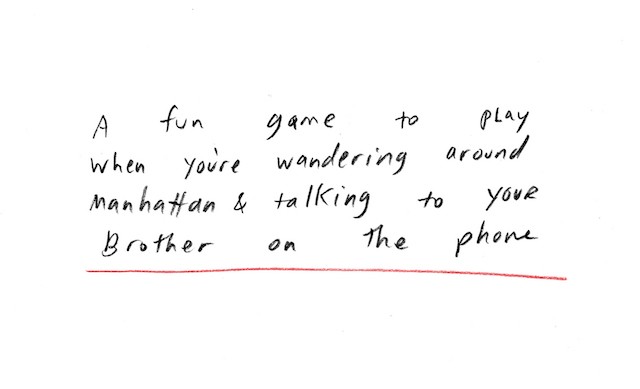
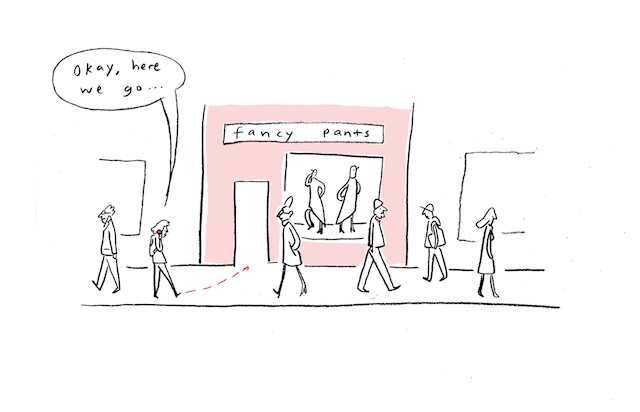
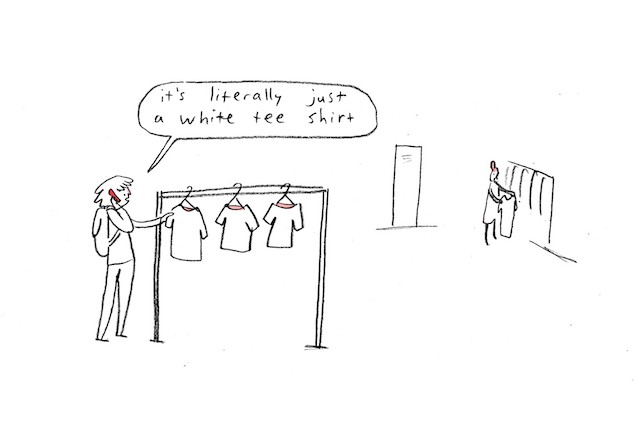
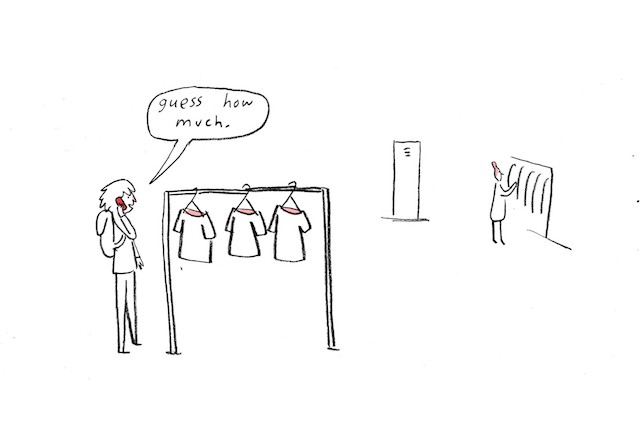
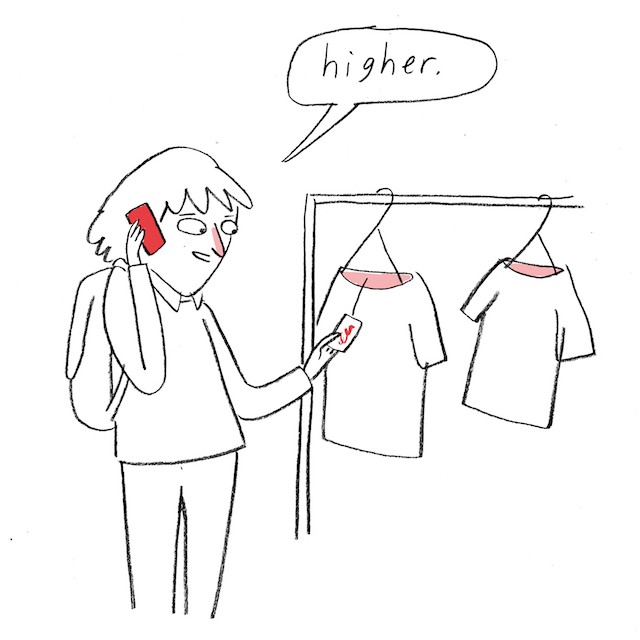

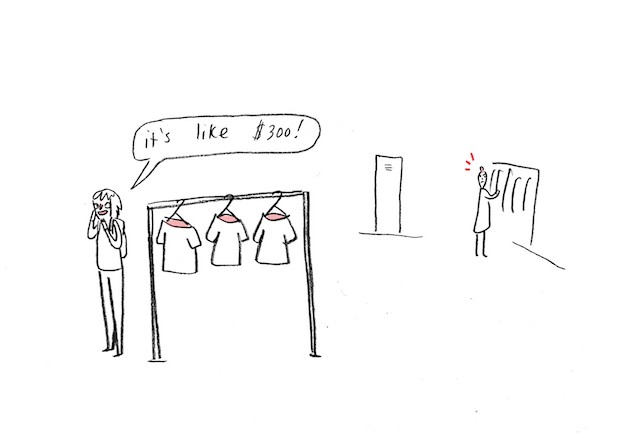
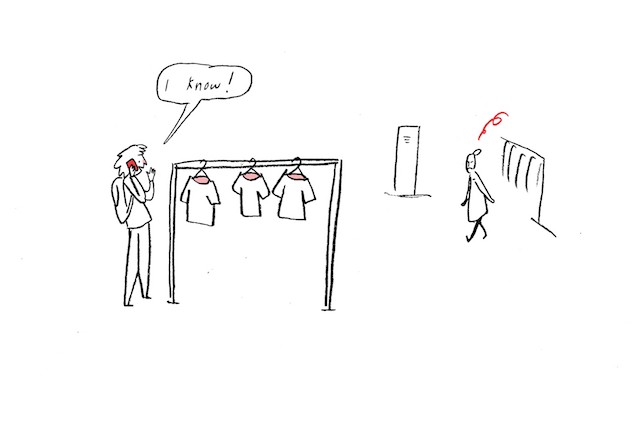
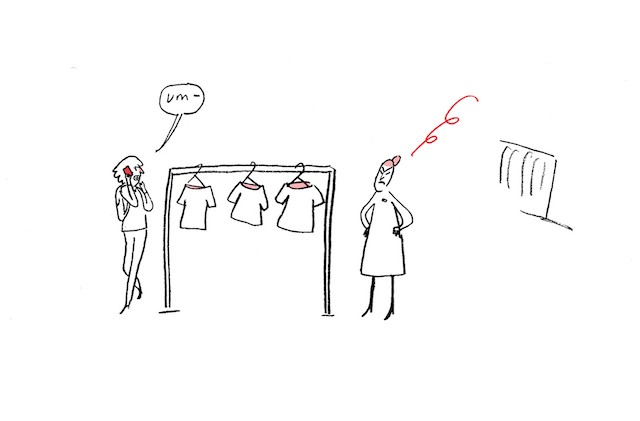
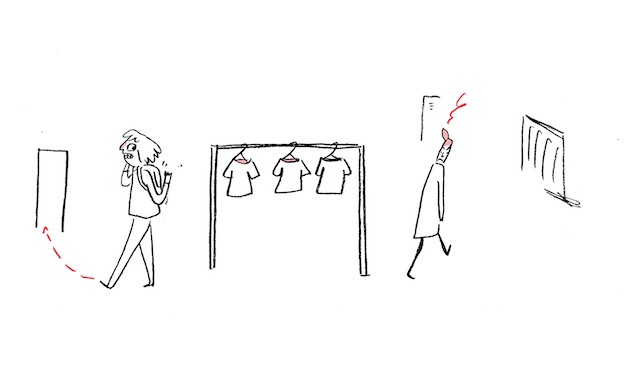
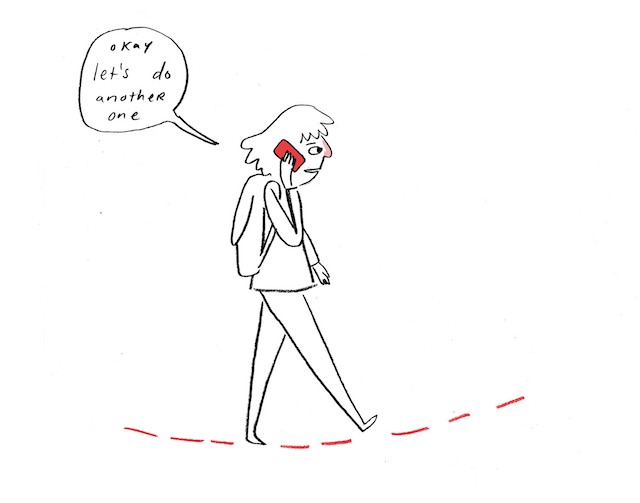
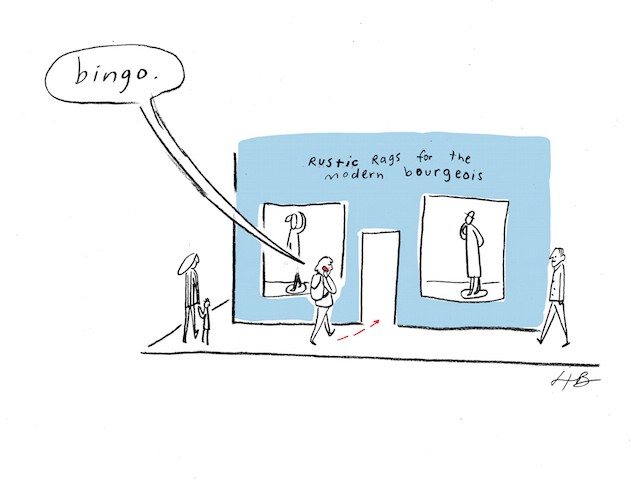
Hallie Bateman is a freelance illustrator and cartoonist based in Brooklyn. She is on Twitter and Instagram. She doesn’t want your attention but she needs it.
The John Oliver Video Sweepstakes: Week 2
Each week, the ᴄᴏɴᴛᴇɴᴛ industry observes a sacred ritual: Together, but not quite in sync, dozens of websites embed and then post the longest segment from John Oliver’s HBO show, Last Week Tonight. That John Oliver’s weekly video(s) will go viral is, at this time, a given. Whether or not the posts that embed those videos will go viral is another matter altogether. Each time around there are winners, losers, and mere participants.
Last week, we congratulated Upworthy, The Huffington Post and overall winner Time, which harvested 21,598 Facebook interactions from John Oliver’s video about sugar. This week’s anchor segment is about state legislative races. Here are the results.
Rank Site Facebook Interactions 1 YouTube 30496 2 Slate 16866 3 Upworthy 15154 4 Huffington Post 6465 5 Mother Jones 5029 6 Vox 4976 7 Bloomberg 2418 8 Raw Story 1685 9 Honolulu Civil Beat 1056 10 Time 1007 11 Washington Post (WonkBlog) 584 12 Grist 548 13 Washington Post (The Fix) 418 14 TruthDig 296 15 The Week 250 16 Wonkette 181 17 Advocate 99 18 BostInno 76 19 The Patriot News 60 20 The Nation 56 21 GoLocalProv 37 22 GovExec 11 23 The Monitor 6 24 OpEd News 2 25 The Spokesman Review 0 26 The Salt Lake Tribute 0
(For links to each of these posts, the raw spreadsheet data is available here. You can try some of the links yourself with these free tools)
This data was collected on Thursday evening, November 6th. The video and its many instantiations are still not done collecting traffic, but the rankings are now unlikely to change in any meaningful way.
At the time of measurement, this video had produced at least 87,776 Facebook interactions. 30,496 of those interactions were claimed by links to the YouTube video itself (which, as was the case last week, was also by far the most Tweeted instance of the video — its competitors were not tweeted much at all).
This left 57,280 surplus Facebook interactions to be claimed by a pool of 24 sites. If these shares were rationed equally, that would work out to about 2,386 free shares apiece. But that is not the world we live in! So congratulations are in order to our top three video posters, as determined by Facebook shares, as measured by SharedCount: The Huffington Post, Upworthy, and, in first place, Slate, which harvested 16,866 Facebook interactions.
So, first, a comparison to last week (this week’s results are on the right):
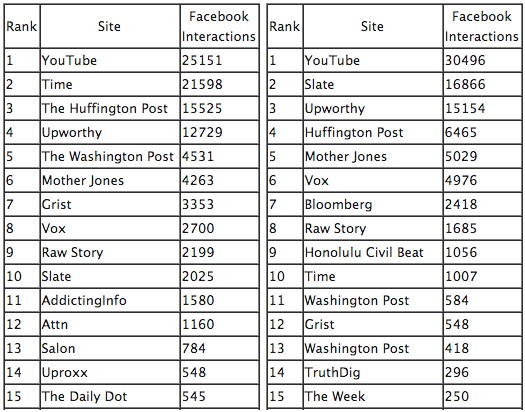
A stunning comeback for Slate, a sad fall for Time. A healthy improvement for Vox, which embarrassed its video embedding rival, The Washington Post’s Wonkblog (The Post had two entries in the top 15, however: One from Wonkblog, and one from The Fix). A consistent performance from Mother Jones. Upworthy remains a resharing powerhouse. Where is AddictingInfo? What is/was AddictingInfo?
The distribution, this week, is a little less brutal than last week’s; the share-to-site ratio is actually pretty high. There is a meaty middle for the not-quite-winners:
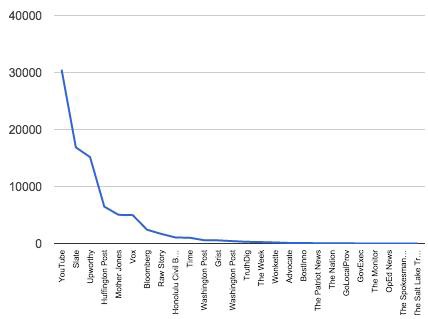
But something, overall, feels amiss. There were fewer than half the number of posts published to embed John Oliver’s anchor segment this week — 24 versus 65. The total number of shares was lower, too, but not by much. Last week was an already unusually slow week for John Oliver content anyway — the video did well, but not as well as most of Oliver’s jokesplains. Was this week just worse? The video is funny and thorough but wonky hard to summarize. It was an easy match for sites that write primarily about politics, but maybe it was too much of a stretch for sites that don’t. But that level of restraint doesn’t really align with the spirit of the whole John Oliver embedding enterprise. Why, in other words, did Bustle post last week’s video but not this week’s?
The answer: A SCHISM. Every week, John Oliver’s show releases a handful of segments on YouTube. Usually, or at least often, the anchor segment — the long destroys/murders/explains/obliterates piece — is the one that sites choose to post. But this week, John Oliver embedders faced a difficult choice: Go with the main segment, or go with this commercial parody segment featuring Nick Offerman.
This is where the missing sites went:
Rank Site Facebook Interactions 1 YouTube 31369 2 Time 10946 3 BuzzFeed 10229 4 Uproxx 5422 5 CinemaBlend 3392 6 Adweek 1520 7 The Daily Beast 1024 8 E! Online 776 9 Entertainment Weekly 709 10 Vulture 654 11 KGW Portland 386 12 Gawker 250 13 DailyLife.com.au 118 14 Junkee 117 15 The Week 111 16 The Raw Story 101 17 Business Insider 86 18 Gizmodo 78 19 The Huffington Post 74 20 Zap2It 69 21 Fast Company 64 22 Jezebel 58 23 Mediaite 57 24 Consumerist 46 25 WhoSay 29 26 Atlanta Journal-Constitution 24 27 Complex 23 28 The Wrap 15 29 The Wall Street Journal 8 30 Laughspin 8 31 Hollywood Life 7 32 HuffPo UK 3 33 InTheCapital 3 34 Business2Community 2 35 UPI 1 36 SocialNewsDaily 1 37 Philly.com 0 38 Uinterview 0 39 Bustle 0 40 1370 WSPD Toledo 0
67,780 shares, 36,411 up for grabs, 39 contenders. This list contains a lot of sites you might remember from last week — the strangest of the already strange bedfellows — that didn’t spring for this week’s big segment: Bustle, Complex, UPI, Zap2It. Whether going with this video over the other was the wrong choice is hard to say. The John Oliver Sweepstakes is, in the end, about gambling.
Of course, some sites saw not a choice but an opportunity: Time, last week’s anchor segment winner and this week’s anchor segment sob story, is fortunate to have posted both. HuffPo posted both videos, too, with a bonus Home Depot embed from HuffPo UK. It was, however, less successful in its second and third attempts. Nobody said the rules couldn’t change!
Anyway, again: Losers, stay strong. Winners, don’t get too complacent. All, adapt. Who will win? Who will lose? Who will rise? Who will fall? UNTIL NEXT WEEK.
The ᴄᴏɴᴛᴇɴᴛ ᴡᴀʀs is an occasional column intended to keep a majority of ᴄᴏɴᴛᴇɴᴛ coverage in one easily avoidable place.
Why 'Wooden Boat Restoration Quarterly' Doesn't Do Clickbait
by The Editors of Wooden Boat Restoration Quarterly

I will let you in on a little industry secret, one we’ve known for years. Clickbait doesn’t work in magazines. I know, I know. But hear me out. Magazines are printed on paper. There is simply no way to “click” on them! Readers would hate that, because it would be impossible. That’s why we stopped using clickbait in our magazine — in fact, we never started. Our goal is to do good work that people want to share — by physically lending their magazines to other people. And I’ll tell you a bad way to get that result: Misunderstanding the material nature of our product, and optimizing for behaviors that do not make and have never made sense in the context of printed quarterly magazines. Different people use the term “clickbait” differently, and it’s sometimes thrown our direction to characterize entertaining wooden boat restoration content that the author doesn’t like. That is something different, a matter of taste. But whatever your taste, nobody likes pretending to click, with a finger or a disconnected mouse, on paper. In conclusion, Jon Stewart is wrong.
Context Provided
“The Army is dropping the use of the term “negro” in an official document that listed it as an acceptable way to refer to African Americans. CNN first pointed out the document on Thursday and just hours later the Army responded by revising the document. At first blush, this sounds controversial, but a bit of context is in order: Remember, the Census just dropped the term last year. As we reported, the Census received lots of complaints about the word in 2010.”
New York City, November 5, 2014

★★ Dawn sunlight, the color of regular-grade olive oil, washed over the buildings briefly, under wrinkled gray clouds. Then the light departed, never to return. The clouds smoothed out, and then more crumpled ones moved in. The river was light gray with tiny wavelets on it. Linden leaves lay curled and yellow on the rubber padding by the empty climber as the preschooler killed time before preschool; the oaks beyond the fence were just beginning to redden. A squirrel hunched over and scrabbled in the leaves and mulch under the shrubbery. Under the scaffolding, on the high edge of a planter, amorous teens clinched. Again the clouds went smooth, the sky dull and blank through the rest of the lightless day. The mildness never blossomed into warmth.
Sympathy for the Nerd

If you wander for a while among certain nerd gathering-places like 4chan, or 8chan, or Wizardchan, you will see dozens of casual references to “Chad.” Chad is handsome, tall, confident and rich; he has “10/10 style” and “six pack abs” and rich parents; he is well hung, well traveled, can make interesting conversation with anyone, and is “highly skilled in the erotic arts.”
Chad, or as he became known more recently, Chad Thundercock, does not exist, but when you live in a fantasy world that doesn’t matter a bit; since first materializing sometime in 2006, Chad has become a sort of virtual water cooler, something for fellow-believers to gather around, like Ebola or ISIS or One Direction. He is an emanation, the real product of a mass hallucination — a sort of Patronus of male nerd insecurity.

The Internet’s sudden, explosive creation of concentrated wealth over the last twenty years gave rise to a thousand headlines blaring “Revenge of the Nerds” stamped over photographs of Mark Zuckerberg smirking in his infernal hoodie and Steve Jobs in a black turtleneck, aloof and superior. “Are ‘Geek’ and ‘Nerd’ Now Positive Terms?” mused the BBC; “Silicon Valley is nerd central,” the New Yorker slangily observed. In normalizing or even exalting the idea of “nerds,” the media conflated a million subcultures into one — but there hasn’t ever been just one. To be a nerd is not at all just a matter of “being into computers” and it never was: in reality, it’s about alienation.
As the Internet grew, the alienation and frustration of the nerds never really went away, but were instead all thrust into its dankest corners, where it has festered and morphed into something very ugly, and very sad. And these sad, naive nerds, in their loneliness and disaffection, have shown themselves, time and again, to be painfully vulnerable to manipulation. Senseless ragestorms and stampedes come thick and fast among them, as any cursory examination of their fora will attest. They’ve moved against game developers, against Reddit, against “social justice warriors” (this is a slur, incredibly), against Adrian Chen and Taylor Swift.
There is a real tragedy taking place in this culture, a sort of apotheosis of suffering amongst the “original” nerds — by whom I mean the ones who went mostly ignored before the Internet came along and created a mythology around them, those self-described outcasts who have had even their own tribe stolen from them, as it slowly became quite cool to identify as, or to be called, a nerd — that is to say, a nerd of a certain kind. The Jemaine Clement kind of nerd. The Rivers Cuomo kind. Not the kind who is still living at home at twenty-six and is too scared to talk to girls.

Wizardchan is an imageboard for adult male virgins, or more specifically, “a Japanese-inspired image-based forum for male virgins to share their thoughts and discuss their interests and lifestyle as a virgin. The name of our website is inspired by the wizard meme, which refers to someone who has maintained his virginity past the age of thirty. In contrast to other imageboards, Wizardchan is dedicated exclusively to people who have no sexual experience and may be NEET [Not in Education, Employment or Training] or hikkikomori.”
There is a shocking amount of pain, rage and confusion on display at Wizardchan, as there is on 8chan and 4chan, even if you’re familiar with the extremes of such things we sometimes see at Reddit. The wizards are really super especially mad at Chad.

These young men are nervous wrecks gathering to compare — or compete over — who is the most damaged, the most depressed, the most pathetic. A lot of them are suicidal, on meds. They call women (all women) “succubi” and talk to one another about how often they “masterbate” or “fap”. The main thing on their minds is sex, like most anyone in his twenties, I guess, but here it is distressed, frantic, frustrated, suffering. They live in the basement, they wish they’d been aborted, all these terrible things. They can’t look in the mirror because their own ugliness makes them cry. I mention all this not because I mean to mock them, but to point out that there are many kinds of nerds, and this kind is at the end of a certain continuum of alienation. On the very extreme end of it. These people are badly damaged; what are we doing to them?


There is this vast distance between the wizards, way over on one end of the nerd spectrum, and the media mythology praising the nerds of Silicon Valley on the other.
Marc Andreessen, the Captain Wrongway Peachfuzz of Silicon Valley, for example, fancies himself a nerd.
It is a common but incorrect myth that Silicon Valley is bro culture. Silicon Valley is nerd culture, and we are the bro’s natural enemy.
— Marc Andreessen (@pmarca) September 27, 2014
Marc Andreessen is not a nerd. I will not go so far as to say that he remotely resembles Chad Thundercock, but Andreessen is nevertheless a gregarious, wildly successful entrepreneur and investor with a net worth of hundreds of millions of dollars, and he is married to an heiress. (Maybe his old partner Eric Bina, whom Andreessen has credited with doing “the hard programming” of Mosaic on a diet of Skittles and Mountain Dew, is, or was, something of a nerd.)
It’s the glamor of men like Andreessen, the hypnotizing effect of their wealth and their influence that is at the root of the change in the public’s perception of nerd culture, and that has served to further alienate the nerds of 4chan, 8chan, Wizardchan, and communities even further flung.
There are some whose feelings of resentment and alienation make them cruel, and others in whom the same feelings result in depression, or persecution mania, or snaky Machiavellian deceit, and still others who are somehow able to transcend such feelings. Such as Arthur Chu, who recently wrote very movingly about meeting Felicia Day — a woman gamer recently targeted by Gamergate activists, and one who had once helped Chu emerge from the solipsism and misanthropy of his youth. Chu’s successful integration into mainstream society has made him a polarizing figure among the nerds, unsurprisingly, complete with a ragestorm of his own.
Almost everyone, even the most beautiful and accomplished among us, grows up thinking of himself as fragile, vulnerable, insecure, hanging by a thread a lot of the time. So because hearing about fear and insecurity is familiar to everyone, it is very easy to forget the breadth of the nerd spectrum, or the wider spectrum of human alienation. There are so many people in the world who are truly alone, who never were invited to a single party or made one single friend, who’ve never been kissed, who literally do live with their parents and never, ever speak to anyone; if we learn anything from the increasingly volatile lashing out of certain nerd communities, perhaps it should be that pain is pain, and that it is real and it all ought to be taken seriously and treated with compassion, instead of going, “Ew.”
Maria Bustillos is a writer and critic in Los Angeles.
Photo by Ronald Heft
The Last Autos Editor
by David Shapiro
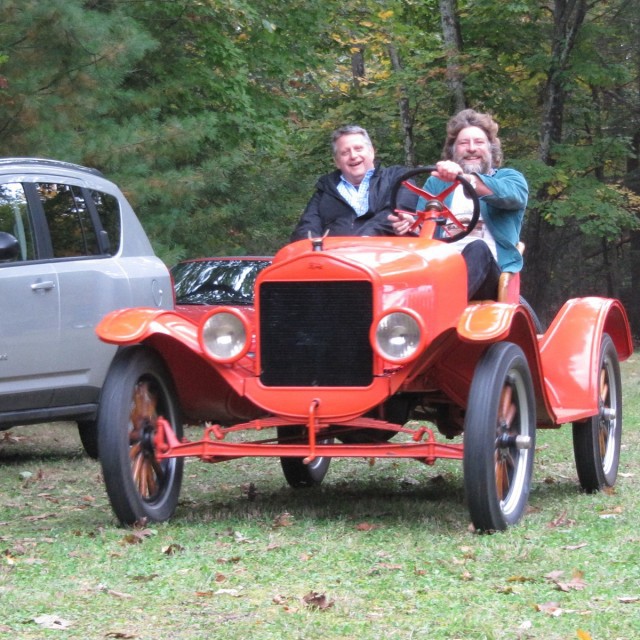
Last Wednesday morning, The New York Times announced that it would stop publishing the Automobiles section, a standalone section that comes out on Sundays, at the end of the year. I thought, like, “Damn, I love that little section.” It’s like Car Talk in that you don’t have to care about cars, or know about cars, to get something out of reading it; it’s full of quirky stories about people obsessed with their cars, e.g., Swedish people obsessed with classic American cars that look like they’re rotting. And a lot of the car reviews feature copy that could have been plucked from deep in the Styles section. (From the new Mercedes S550 review: “A cabin atomizer infuses the air [inside the car] with four scents: Nightlife Mood, Sports Mood, Downtown Mood and Freeside Mood. They all smell like money to me.”)
But I guess the Automobiles section is to the Times as an automobile is to most New Yorkers — you don’t need it, though it’s fun to have one around (at least long as you have advertisers!). Yesterday, I called Jim Cobb, who’s been the section’s editor since its inception in 1994. He’d just come back from a long weekend in Florida following the announcement that the section was being killed. He sounded bummed, but eager to talk about the section he birthed, raised, and is now burying.
Where do you live? What do you drive?
I moved out of Manhattan a few years ago — I live just across the river in New Jersey. And I have — this is crazy — a Dodge Ram Sport 4X4 with the off-road package! The door sills come up to about my thighs. It’s just a big honkin’ truck and it looks mean. Beyond that, my partner has lease vehicles. And I drive test cars.
Ah, I sort of expected you to drive a Prius. I guess, like, as the Times Automobiles editor. But you’re also a car person, and I know car people generally hate those…
That’s not gonna happen. Not that there’s anything wrong with it for what it is, but it’s the automotive equivalent of seven-grain bread.
How did the section start?
It was started in April of 1994. I got involved because I’d worked in the business/finance section; I’d lived in Detroit; and I liked cars. So I met the three criteria they had in mind. My understanding was that the advertising department had been pushing for some time to do a freestanding Automobiles section and they had been rebuffed by the newsroom because it wasn’t Timesian. But eventually, they wore the newsroom down. Max Frankel, the editor at the time, relented, under the proviso that whatever criticism we did, we would do it it in a Timesian way: We would hew to our ethics standards and wouldn’t buy into the usual way automotive journalism is conducted — lots of free trips and paid launch events. We would also pay for the use of test cars. To this day, we still pay rental fees.
What does it cost to rent a BMW i8?
Well, we cap it. We pay within reason. A Rolls Royce for a week? Who even knows what that’s worth.
What in the section are you very proud of?
Well, fairly early on, we raised some very skeptical eyebrows at the proliferation of in-dash infotainment controls that can be very distracting. I reviewed the BMW 7-Series in 2001 — it was one of the first BMWs with iDrive [a Windows-based computer system, controlled by a knob, which is used to adjust things like the navigation, air conditioning, and sound system in BMWs and famously shitty and nearly impossible to use], which was fairly revolutionary for the time. It was… a bit of a mess. We jumped on that. Is this really a good idea? To have menus and submenus and a Windows-based computer screen in your dashboard when you’re driving at seventy-five miles per hour? We were among the first to start raising the alarms about that.
The complexity of the technology in cars and trucks right now — it’s all just a little too much! It’s refreshing, these days, to get into something like a Mazda3 or something as prosaic as the Volkswagen Golf, and to feel how simple the act of driving can be. Without the submenus that torment you, features you don’t need and largely can’t understand. The complexity really bothers me.
So the BMW 7-Series review earned me my first footnote on Wikipedia. Of anything I’ve written, that review and the sidebar that went with it were among the things I’m more proud of.
And we’ve had great reviews from a lot of great contributors, including some that caused a lot of grief from the manufacturers!
Like that Mitsubishi Mirage review? [“Low expectations don’t guarantee happiness, but at least there isn’t much disappointment. The reborn Mitsubishi Mirage lowers expectations, strangles them and buries their remains in a deep unmarked grave. If this car wasn’t disappointing, it wouldn’t be anything at all… A 5-speed manual transmission is standard, but $1,000 buys the (C)ontinuously (V)ariable (Transmission). C.V.T.s are easy to hate, but this one is particularly loathsome in operation. As the engine slogs to its peak torque of 4,000 r.p.m., the C.V.T. seems to be trying to smother it. Once at the peak, the powertrain settles into a bleak drone as the car grimly builds something like speed. The sound is flatter than the electroencephalogram of a dead hamster.”]
Never heard from them about that! But I have a bulging file of letters from executives of the old General Motors, from the nineteen nineties — they thought we hated them, but they were making crap cars. They seemed to think we were overly harsh.
Dan Neil, the first automotive writer to win a Pulitzer, came onboard early in the early nineties. I won’t say I plucked him out of obscurity, but he was writing down in North Carolina for some alternative papers. Hell of a writer, terribly astute, sometimes a little “out there.” At one point, he called the Pontiac Grand Prix out as having a Hitler mustache. GM didn’t think that was funny at all. We had go-arounds with several Cadillacs that were not so well-received. I’m a big fan of Cadillac today, but they were making some dreadful stuff in the nineties.
How is car culture different today than when you started?
Collector car culture is just huge and getting ever bigger. We’ve waded further into the collector milieu with a lot of auction coverage and a lot of collecting coverage; baby boomers are driving a lot of the interest. The prices of vintage cars have soared — all the things I wanted to own in the early nineties, like a ’65 Mustang or a Mercedes 280 SL Pagoda, cars that were fifteen, twenty, twenty-five thousand dollars back then — they suddenly cost six figures. It’s just insane.
What led to the section’s demise? Was it the classified ads?
The classifieds have been a moot issue for years — they dried up and went away long ago, with the arrival of Craigslist and everything else. There were some, but not page after page like the real estate listings. What does support us is dealer advertising and dealer associations, like the Lexus Dealers of Greater New York, that has its own marketing budget, and then the individual dealers in New Jersey, Long Island, Westchester. That advertising has fallen off quite a lot. At one time, our sections were twenty-four, twenty-eight, maybe thirty-two pages, but of late we’re running six pages, eight pages, maybe ten. With house advertising.
Did you fight to save the section?
I had no chance to fight it. The decision had already been made.
It’s a sad thing, and it’s been fun, but there’s so much I wish we could have done. We’ve had lots of plans, and now the realization that we won’t do those things…? It’s sad.
Tell me about, like, a fond memory of working on a story.
Oh, gosh. [Pause.] I don’t know why this springs to mind first, but we did a whole section, and a digital presence, on the centennial of Chevrolet in 2011. We had a lot of fun with it. We had the blog going then, we asked people to contribute their photos and memories of Chevrolets. We had some cool videos, slideshows, a lot on Chevy design and the technology that was pioneered by Chevrolet.
Also, one of our contributors, Paul Stenquist, owns a 1955 Chevy Bel Air convertible, and we assigned a review of it in 2011 as if it were just coming out today. [Laughs.] We had a lot of fun with it.
Michael Winerip, of the NYT staff, had severe flood damage from Sandy, and it totaled out his beloved VW Cabrio. So he followed the car through the disposition process, from insurance claims to salvage yard to, finally, the crusher.
In the course of reviewing the new Chevy Cobalt in 2005, Jeff Sabatini (well, his wife) experienced the ignition-switch problem that has led to millions of recalled cars. Little did we know then how widespread the problem was, but we wrote about it.
We have also tested a hovercraft and a lunar rover.
And, of course, I put the incredible Dwight Garner, book critic deluxe, into a Lamborghini, just because I love the way he writes.
What do you think you’re going to do now?
[Pause.] None of that has quite shaken out yet. There are a lot of changes coming to the Times in the next couple of months, so everything is sort of up in the air. I’m waiting to see where the pieces fall.
Correction: The Chevrolet centennial was in 2011, not 2012.
David Shapiro is the author of You’re Not Much Use to Anyone
Photo of Cobb being driven by Arthur Vogel of the Woodstock Motor Club in a Model T courtesy of Jim Cobb.
An Episode Guide for the Birth of a Neighborhood

“Pilot”
MARCH, 1985: Ridgewood has traditionally been a closely knit ethnic community, where houses are passed down from generation to generation, where European languages can be heard in the streets and where, in the summer, neighbors sit on their front stoops and chat.
But the recent designation of parts of this blue-collar neighborhood in Queens as a Federal historic district is prompting changes. Tenants are buying their own homes and young professionals are moving into the community.
“The ethnicity of the neighborhood appeals to us,” said Mrs. Burnett, a 25-year- old social worker. “With Germans, Italians and Yugoslavians living and working in the area, even the shops and restaurants have an Old World charm.”

“A Danger Lurks”
AUGUST, 1994: Bushwick stands nearby as a constant reminder of what could happen when a neighborhood lets its guard down.
A small but sturdy community on the southwest edge of Queens, across the street from Brooklyn, Ridgewood watched in fear as Bushwick set itself aflame in the 1960’s and 70’s, culminating in the July 1977 blackout that produced a night of smoke and looting. “Ridgewood has only five years left to go” was the popular phrase 25, 20 and 15 years ago among doomsaying residents, convinced that Bushwick’s blight would spread.

“A Change Begins”
OCTOBER, 2003: Not long ago, Ridgewood, Queens, was the city’s quintessential German neighborhood, where residents would flock on weekends to the nearby Metropolitan Oval for soccer matches between teams with German names, follow up the game with sauerbraten, dumplings and beer, and end the day with polkas at a German social club.
But in this season of Oktoberfests, it is all the more obvious that Ridgewood is losing its Germans and the city is watching another of its signature enclaves turn into something more cosmopolitan.
At the Alster Gift Shop, the neighborhood’s last outpost of German wares, the shelves are as sparsely stocked as the customers are few. Metropolitan Oval, in Maspeth, where teams with names like Blau-Weiss Gotschee played dust-filled soccer behind a screen of row houses, is now owned by a foundation that serves a cross-section of ethnic groups.

“A Promise Gleaming”
APRIL, 2006: In this small working-class enclave abutting Bushwick, Brooklyn, barely 20 minutes from Manhattan by subway, street after street is lined with neat row houses, some of them with elegant bow fronts or warm yellow-brick facades edged with crisp white trim. The sidewalks are wide and clean, but if it were up to Paul Kerzner, president of the Ridgewood Property Owners and Civic Association, it would be even more spotless.
Prices in Ridgewood are going up, but not as quickly as in other neighborhoods like hipster Williamsburg or increasingly yuppified Greenpoint, both nearby in Brooklyn. Ridgewood is a bargain by contrast, with some homeowners buying two-family units and using them for one family alone.
“We are getting a lot of people from Williamsburg and Greenpoint, selling there for $1 million, then buying in Ridgewood for $550,000,” Mr. Crifasi said. “Other people are coming to Williamsburg, then realizing that if they go three or four stops further east on the subway, they can pay half the price, or at least 30 percent less.”
Parking availability could be improved; the daily ritual of finding a parking space can be a nightmare. The assortment of retail stores is certainly vast, but a few more upscale spots are on the wish lists of some residents. “A Starbucks would help,” Mr. Kerzner said.

“A Boundary Questions”
NOVEMBER, 2007: There has seemed to be a bit of confusion whether or not the evicted loft tenants (“hipsters” to some) of 17–17 Troutman actually lived in Bushwick (Brooklyn) or Ridgewood (Queens).
A press release apparently went out saying they were Bushwick residents, while the answer is: technically the building lies in Ridgewood.
In the same way that Bushwick was once rebranded East Williamsburg by real estate agents, perhaps now Ridgewood is now (East) Bushwick. Would that make it East East Williamsburg?

“A Frontier Remolded”
MAY, 2008: KERMIT WESTERGAARD grew up on the Upper East Side, far from hammers and paintbrushes. Yet early on, he was seized by the idea of renovating a historic house for himself. Last year, he got the chance when he and his wife, Azadeh, bought a 1908 row house in Ridgewood, Queens, for $592,000, and turned it into their comfortable fantasy of a simple upstate farmhouse.
Ridgewood, which is rapidly being populated by Polish émigrés priced out of Greenpoint, along with many Latinos and Asians, has the look of brownstone Brooklyn.”I think there must be 20 different nationalities on this block alone,” Mr. Westergaard said, “and we socialize all summer on the porches.”
“When we opened an upstairs closet to find it full of vintage children’s books, we knew it was a sign,” Mrs. Westergaard said.

“A Beacon Deployed”
JANUARY, 2012: WHEN it comes to areas awash in well-kept old buildings, Ridgewood, in west-central Queens, might not come to mind as quickly as, say, Brooklyn Heights. But maybe it should.
Currently, the area is attracting a different type of artists priced out of Williamsburg in search of cheaper lofts, which they have discovered along Ridgewood’s gritty edges.
Since 2003, Roman Popescu, a developer, has lived in a 2,500-square-foot loft at a former train-engine shop, near the border with Bushwick, Brooklyn. His parents, who are from Romania, ran a knitting mill in the building, which cost $250,000 in 1994. Mr. Popescu convinced them it had greater potential for artists, so they converted it.
“Williamsburg became as crowded as Union Square, and artists need great big spaces,” said Mr. Popescu, who now has all 13 spaces leased to artists or artisans, some of whom also live on site. He is seeking a zoning change to allow nonartists to reside there, too.

“A Signal Received”
MARCH, 2012: THE race to anoint the latest neighborhood for New Yorkers eager to pursue careers in the arts is never-ending.
Greenwich Village, for much of the 20th century the heart of American Bohemia, was shoved aside by one after another newcomer, first the East Village, then SoHo and the Lower East Side, and most recently the Brooklyn quartet of Williamsburg, Greenpoint, Bedford-Stuyvesant and Bushwick. These days, a new destination seems to be proclaimed every few weeks, as artists rush about pell-mell in search of fresh terrain to colonize.
Matthew J. Mahler is one of the growing number of newcomers you see these days on the streets of Ridgewood, Queens. Mr. Mahler, 30, has a master’s degree in fine arts from Queens College and is a painter. With Jonathan Terranova, a childhood friend from Long Island, he runs the Small Black Door, a basement gallery on Palmetto Street.
Mr. Mahler has many artist friends who have moved to the neighborhood in the past few years, paying from $1,200 to $1,600 for two-bedroom spaces like his own. Despite the lure of neighboring Bushwick, he expects their numbers to increase. “Bushwick has a lot of wind in its sail,” he said, “and people who live here end up hanging out in Bushwick a lot. Ridgewood is still a hidden gem. It’s not the hippest neighborhood. But it’s getting there.”

“A Land Despoiled”
AUGUST, 2013: It was only a matter of time, after Bushwick was given a featured role in the HBO show “Girls,” that the young creative types who established this gritty Brooklyn neighborhood as an artists’ enclave began to be priced out.
Now, with such mainstream endeavors looming and prices on the rise, artists, 20-somethings and young families are taking the L train for the short hop to neighboring and more economical Ridgewood, Queens.
Alex Amini, a 24-year-old bass player, is paying just $600 a month to share a large three-bedroom duplex in a renovated Ridgewood row house with four other people. “It’s the biggest apartment I’ve ever had,” he said, “and it’s the cheapest.”

“A Frontier Christened”
JUNE, 2014: To the trophy-hunting diner, the more difficult a restaurant is to find, the more alluring it is. Consider, then, the checklist for Houdini Kitchen Laboratory: No sign. Unmarked entrance at the back of a former brewery. (Better yet, through a fence to the back “yard,” a.k.a. loading dock.) On a bleak block of industrial buildings with graffiti palimpsests and rusted drips from what pass for windows.
Of course, there are now artist studios upstairs, and a free tattoo party may be in swing down the street. But to a first-time visitor, clutching a MetroCard, the scene is desolate. You are 10 stops out of Manhattan on the L line, in the borderland where Bushwick, Brooklyn, blurs into Ridgewood, Queens. (Welcome to Quooklyn.)

“A Paradise Found (Season Finale)”
NOVEMBER, 2014: “When I first moved there, I never saw people that were my age,” said Caitlin White, 26, an editor at MTV News who moved to Ridgewood last year from Red Hook, Brooklyn. Since then, she has noticed a demographic shift. “Creative people love to be the ones that explore new territory,” she said.
Ridgewood is in the chrysalis stage of an outer-borough transformation that shrieks “Brooklyn.” Except it’s not in that overhyped borough.
“Most people were like, ‘Queens? You’ve got to be kidding,’” said Brian Taylor, who is opening Onderdonk & Sons, a beer and burger joint on Onderdonk Avenue this month. He is an owner of the Pencil Factory, a popular bar that opened 14 years ago in Greenpoint, and now feels priced out of that neighborhood. “People are saying ‘Ridgewood, that’s the hottest place ever.’”
Photo by Tom Lin
It Was Never Really About Books
This is the most important paragraph in Keith Gessen’s big Vanity Fair piece about publishers and Amazon:
The success of Amazon changed all that. It has been said that Amazon got into the book business accidentally — that it might as well have been selling widgets. This isn’t quite right. Books were ideal as an early e-commerce product precisely because when people wanted particular books they knew already what they were getting into. The vast variety of books also allowed an enterprising online retailer to leverage the fact that there was no physical store in a single fixed location to limit its inventory. If a big Barnes & Noble had 150,000 books in stock, Amazon had a million! And if Barnes & Noble had taken its books to lonely highways where previously there had been no bookstores, Amazon was taking books to places where there weren’t even highways. As long as you had a credit card, and the postal service could reach you, you suddenly had the world’s largest bookstore at your fingertips.
You can extrapolate from here and understand, basically, what Amazon is: A giant, product-agnostic logistics operation. It cared a lot about books when books represented a singular opportunity; it cares less now that they don’t. You can imagine Amazon executives reading all these quotes from publishers and thinking, Jesus, what are they talking about? And who are they talking to?
Similarly essential: The video above, posted by Amazon today, showing off the experimental “Echo,” a Siri-like robot stick that sits around your house and answers questions. Like Amazon’s drone delivery videos, it’s meant to play as ambitious — to position Amazon as a company with big ideas for the future, which is otherwise frighteningly ambiguous and fragmented and weird. And Amazon does have big ideas for the future! Big ideas for its future, in particular, in which it wants to sell you more things in more intimate ways. The human behaviors portrayed in this video that don’t involve purchasing products — “So, this thing is listening all the time? Cool. Alexa! Play me some rock music!” — are human-ish at best. Books fit into Amazon’s long-term vision to the extent that the company believes you will be asking your ecommerce log, or your ecommerce tablet, or your ecommerce implant, to deliver them to you by mail or by drone or by app, and not a bit more.
